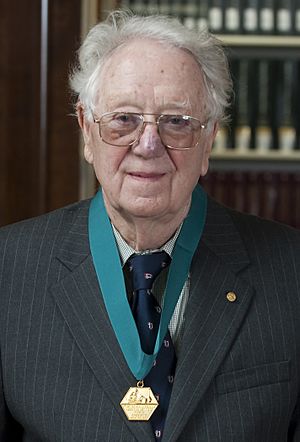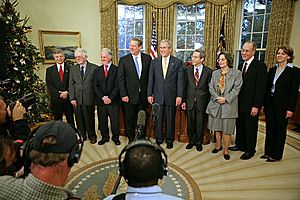Oliver Smithies facts for kids
Quick facts for kids
Oliver Smithies
|
|
|---|---|

Smithies with the American Institute of Chemists Gold Medal (2009)
|
|
| Born | 23 June 1925 Halifax, West Yorkshire, England
|
| Died | 10 January 2017 (aged 91) Chapel Hill, North Carolina, US
|
| Nationality | British, American |
| Alma mater | University of Oxford (BA, DPhil) |
| Known for | |
| Awards |
|
| Scientific career | |
| Fields | |
| Institutions | |
| Thesis | Physico-chemical properties of solutions of proteins (1951) |
| Doctoral advisor | Alexander G. Ogston |
| Influences | Norma Ford Walker |
Oliver Smithies (born June 23, 1925, died January 10, 2017) was a brilliant British-American scientist. He was a geneticist, studying how traits are passed down through families. He also worked as a biochemist, looking at the chemistry of living things.
Smithies is famous for two big discoveries. In 1955, he found a new way to separate tiny particles using starch. This method is called gel electrophoresis. Later, he helped discover a powerful technique called gene targeting. This allows scientists to make very specific changes to the DNA of animals. This work led to the creation of "knockout mice." These mice have specific genes turned off, which helps scientists study diseases. For his amazing work in genetics, Oliver Smithies won the Nobel Prize in Physiology or Medicine in 2007.
Contents
Early Life and Education
Oliver Smithies was born in Halifax, England. His father sold life insurance, and his mother taught English. He had a twin brother and a younger sister. Oliver went to primary school in Copley and then to Heath Grammar School. He said his love for science started with his early interest in radios and telescopes.
He went to Balliol College, Oxford on a special scholarship. He first studied medicine, learning about the human body. He did very well, earning a top degree in animal physiology, which included biochemistry. A teacher named Alexander G. Ogston inspired him to combine physical chemistry with biology. So, Smithies decided to study chemistry instead of medicine. He published his first research paper in 1948. In 1951, he earned his PhD in biochemistry.
Career Journey
After his studies, Smithies moved to the United States for a research job. He worked at the University of Wisconsin–Madison. Because of visa issues, he then moved to Canada. From 1953 to 1960, he worked at the Connaught Medical Research Laboratory in Toronto. There, he learned about medical genetics from Norma Ford Walker.
In 1960, Smithies returned to the University of Wisconsin–Madison. He worked there in the Department of Genetics for many years. Later, he became a professor at the University of North Carolina at Chapel Hill. He loved his work so much that he continued to go to his lab every day, even when he was in his eighties. He wrote more than 350 research papers during his long career.
Groundbreaking Research
Smithies created a new way to do gel electrophoresis. This technique uses a special starch gel to separate proteins. It made it much easier for scientists to study different proteins. He used this method to show how human plasma proteins could be different. This discovery made him very interested in genetics.
In the 1980s, while at the University of Wisconsin, Smithies developed gene targeting in mice. This amazing method allows scientists to replace specific genes in a mouse. Another scientist, Mario Capecchi, also developed this technique around the same time. This research is now used all over the world. It helps scientists understand how specific genes cause diseases. These diseases include cancer, cystic fibrosis, and diabetes. In 2002, Smithies worked with his wife, Nobuyo Maeda. They used genetically altered mice to study high blood pressure.
Awards and Recognition
Oliver Smithies received many important awards for his scientific work. In 2001, he won the Albert Lasker Award for Basic Medical Research. He shared this award with Martin Evans and Mario Capecchi. They were honored for their work on homologous recombination. He also received the Wolf Prize in Medicine in 2002/3.
His biggest honor was the 2007 Nobel Prize in Physiology or Medicine. He shared this prize with Capecchi and Evans. They won for their discoveries about changing genes in mice. Their work used special cells called embryonic stem cells.
Other awards he received include:
- Two Gairdner Foundation International Awards (1990 and 1993)
- The North Carolina Award for Science (1993)
- The American Institute of Chemists Gold Medal (2009)
Smithies was also chosen to be a member of many important scientific groups. These include the United States National Academy of Sciences (1971) and the Royal Society (1998). He also received honorary degrees from several universities.
Personal Life
Oliver Smithies married Lois Kitze, a virologist, in the 1950s. They later separated. His second wife, Nobuyo Maeda, is also a professor. Smithies became an American citizen. Even though he was color-blind, he was a licensed pilot. He enjoyed flying small airplanes and gliding. He described himself as an atheist.
Oliver Smithies passed away on January 10, 2017, at the age of 91.
See also
 In Spanish: Oliver Smithies para niños
In Spanish: Oliver Smithies para niños


